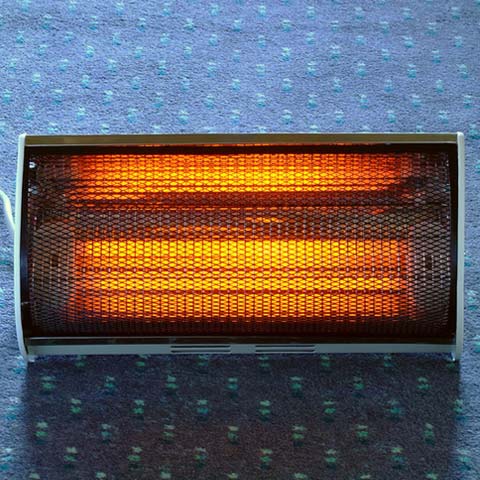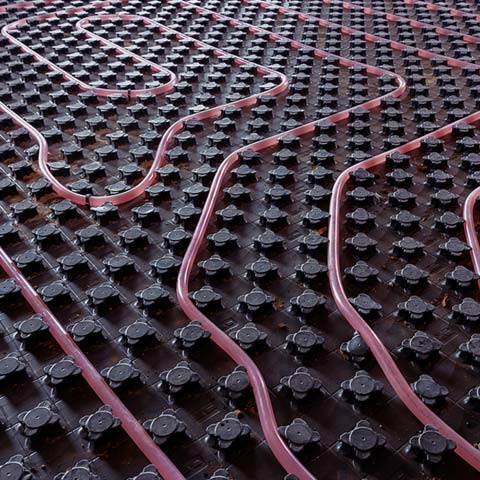Are you wondering how do radiant heaters work?
And how these heating units can heat a room effectively?
If so, this post has the answers you’re looking for.
In this article, we’re going to take you through everything you need to know about radiant heaters.
We’ll inform you of what a radiant heater is, how it works, and even the various types of radiant heaters that are available.
By the end of this post, you’ll know all about the inner workings of radiant heaters and conclude whether this type of heating unit is your best choice.
And once you’re done, be sure to check out our in-depth guide on the best infrared space heater reviews if you need help finding a heater that’s right for you.
What is a Radiant Heater?

A radiant heater generates heat internally and then radiates that heat to nearby objects and people.
A basic example of a radiant heater is the sun.
The warmth we feel on our bodies on a sunny day is due to the infrared radiation (heat energy) that comes from the sun.
Radiant heaters do not heat the air in the room like other types of heaters.
The heat is radiated to the physical objects and persons within the space. Therefore, you won’t experience dry air as convection heaters create.
See all of Amazon's Best Selling Space Heaters
How Do Radiant Heaters Work?
So, how do radiant heaters work exactly?
Radiant heaters operate by producing infrared radiation.
All objects radiate energy at a capacity equal to their temperature. Radiant heaters generate infrared energy that travels in invisible electromagnetic waves that are absorbed by objects on its path.
There are two different ways of producing radiant heat: gas or electricity.
Gas
The gas-air mixture in radiant gas heaters is ignited by an electrode at the surface.
The flame heats the tube and as its temperature rises, the radiant tube heater produces radiant heat.
Due to the waste fumes emitted in the air (just as in diesel radiant heaters and propane radiant heaters), additional ventilation systems are often needed.
If this type interests you, check out our propane heater for house reviews to find good recommendations.
Electric
Electric radiant heaters generate radiant heat by running electricity through metal coils.
These metal coils are placed in the ceiling, floor, or inside a space heater.
The radiant electric heat is then directed where it’s required.
Some of the most efficient space heaters are of this type.
Convection Heater vs Radiant Heater
Thermodynamics and Quantum Mechanics
Radiant heating and convection heating are based on two different processes.
Convection heaters use thermodynamics while radiant heaters use quantum mechanics.
A convection heater heats the air of the room while a radiant heater warms the physical objects in the space.
Due to the heating process, radiant heaters produce a warm climate inside a room, unlike convection heaters.
Therefore, radiant heat doesn’t circulate in the air and the air doesn’t become dry.
Indoor mold formation does not usually occur from radiant heaters either which makes these types of heating units best suitable for people with allergies.
Convection heaters, on the other hand, heat up the air and when it cools down the moisture in the air can condense on the walls and lead to mold growth.
Radiant Heat Operates Like the Sun
As you may know, solar radiation heats the objects in its path. And radiant heating systems produce comfortable heat using a similar method.
Only liquid or solid objects are heated with a radiant heater which then transfers the heat around the room.
Air is permeable to heat rays and that makes the temperature of the room cooler.
That is why radiant heaters are more efficient than convection heaters.
Low Rate of Air Exchange Saves Energy
Radiant heaters work by heating the objects in a room and not the air. Therefore a low amount of energy is consumed during air exchange.
Conventional heating needs to heat all the air in the room to restore the temperature.
During the heating process, some air is moved around by the fan in convection heaters. This can cause dust and other particles to fly around in the air posing irritation to people with allergies and asthma.
The radiant heat from radiant heaters has a low air exchange rate. This process of heating leads to better energy savings and an optimal environment for people with asthma.
Types of Radiant Heaters
Radiant heating can be delivered through a variety of methods to keep a house or room warm.
We’ll now look at the various types of radiant heaters and how they work.
Wall-Mounted Radiant Heaters
Wall-mounted radiant heaters are relatively new to the market and are beneficial in that they’re slim and don’t take any floor space.
Radiant wall heaters offer balanced radiant heat from head to toe.
These units are very safe to use in homes with children or pets because they’re mounted up and off the floor.
You can even get a wall-mounted heater that looks like a fireplace. Check out our wall mounted electric fireplace reviews page for more details.
Permanent Floor Radiant Heaters
These radiant heating systems are installed directly below the floor surface.
Floor radiant heaters are a popular choice to use in the bathroom because tiles can get very cold during winter. And these heating systems keep the ground warm no matter how cold it gets indoors.
Ceiling Radiant Heaters
With this model, the panels for radiant heating are installed in the ceiling. The heat is then radiated to people or objects beneath the ceiling in the room.
Another example of this system is a radiant cove heater.
Cove heaters combine radiant heat and convectional heat and direct it from the ceiling down toward the floor.
These units disperse warm air in the room at minimal temperature to achieve the minimal level of the transfer of heat.
This process works to reduce energy waste and saves money.
Freestanding Radiant Heaters
Freestanding radiant heaters are small portable units that can easily be moved around a room or carried with you.
Some people refer to them as just “portable space heaters”.
The major benefit of these units is that you can take the heat around with you.
They’re also a good radiant heater for garages and small spaces. And like wall-mounted versions, these freestanding heaters can also look like a fireplace. Visit our best electric fireplace heaters guide for more details.
Do Radiant Heaters Use a Lot of Electricity?
No, the cost of radiant heaters is fairly cheap. These heaters do not use a lot of electricity.
Natural gas radiant heaters use no electricity at all since they’re powered by gas. And the electric radiant heater units use infrared heat which is much more efficient than forced air heat from convection heaters.
For example, a small bathroom radiant heater uses less energy than a freezer.
Radiant heaters are very economical and don’t use much electricity at all.
Are Radiant Heaters Bad for You?
Are infrared radiant heaters dangerous?
Are they bad for you?
Do they have health risks?
These are common questions people have about radiant heaters and human health.
Most people associate the word “radiation” with something dangerous such as X-radiation (X-rays) or even nuclear radiation.
But the answer is no, radiant heat is not harmful to your health.
Infrared radiation is naturally produced by the sun and it’s what makes you feel warm on a sunny day. Plus, infrared radiation is very different from microwaves or X-radiation.
People might think since the sun emits UV rays which can damage the skin that infrared heaters might have the same effect.
But that is not the case.
Infrared rays generate the heat we feel with infrared-C radiation (IR-C).
IR-C is considered far-infrared: it travels a long distance to warm a target area.
It’s important to know that far infrared is totally safe as a heating method and should not be confused with near-infrared.
Near-infrared is slightly different from the heat being more intense and penetrating and potentially unsafe.
If you’re exposed too much to near-infrared, then you can get thermal burns and aging effects on your skin.
What is the Difference Between Radiant and Infrared Heat?
Are you confused about infrared vs radiant heating?
Are radiant and infrared heaters the same?
If there’s a difference, which one between the two is better?
This is a subject that confuses a lot of people.
Well, here is the answer…
Radiant heaters and infrared heaters are the same things.
Radiant just means that the heat is produced with radiation while infrared specifies the type of radiation that’s being used.
A radiant heater is a general term but infrared is the only radiation that’s used to heat a room.
Therefore, all radiant heaters are infrared heaters. The radiation that we feel as warmth is infrared heat.
Infrared heat has a longer wavelength than visible light but shorter than microwaves.
However, infrared and radiant heaters work by sending out infrared radiation.
So infrared heat is radiant heat. It’s the same heat that your body emits.
Radiant infrared heating is the transfer of heat from the heater to the object without the air in between getting heated.
How Do Radiant Heaters Work Summary

In conclusion, we’ve answered some of the top questions you might have had concerning how do radiant heaters work.
Most importantly, we’ve seen that radiant heaters and infrared heaters are the same things.
One of the most important benefits of a radiant heater is its energy-saving ability. This is one of the main reasons why radiating heating is so popular.
We hope the information in this article was beneficial in learning how radiant heaters work.
Now, if you want help trying to find the perfect radiant heater for your home, be sure to check out our best infrared space heater reviews to see what’s available.
That guide along with the information in this post will help you make the most informed decision for your needs.
